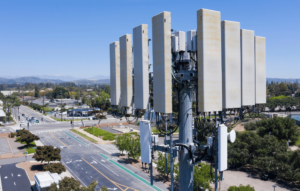In today’s world, we heavily rely on modern telecommunication technologies. They allow us to stay connected, quickly access information, and navigate our daily lives in a way that’s totally different from the majority of human history. However, it’s crucial to ask: is there a cost to all this convenience?
Over the past two decades, the intersection of technology and health has become a hotbed of discussion and legal scrutiny. A court case that highlights these concerns is Murray et al. v. Motorola et al., a lawsuit that began in the early 2000s and serves as a great example of the ongoing debate about the health risks associated with cellphone use and exposure to electromagnetic fields (EMF).
In this blog post, we’ll lay out the significant events surrounding this issue and look at some of the intricacies of the Murray case and its broader implications.
Early Lawsuits (2001-2002)
At the turn of the century, the telecommunications industry was hit with a wave of lawsuits from individuals who claimed they had developed brain tumors from cellphone use. Among these were twenty-nine high-profile lawsuits, with Murray et al. v. Motorola et al. standing out.
These early legal battles set the stage for a prolonged and complex journey. Plaintiffs alleged a causal link between cellphone radiation and brain tumors, sparking debates in courtrooms, scientific communities, and public forums. Other major corporations like Verizon, AT&T, T-Mobile, Sprint, Motorola, Samsung, Nokia, Qualcomm, the CTIA, the IEEE, and the FCC were drawn into the fray, marking the beginning of a legal and scientific discourse that continues to this day.
alleged a causal link between cellphone radiation and brain tumors, sparking debates in courtrooms, scientific communities, and public forums. Other major corporations like Verizon, AT&T, T-Mobile, Sprint, Motorola, Samsung, Nokia, Qualcomm, the CTIA, the IEEE, and the FCC were drawn into the fray, marking the beginning of a legal and scientific discourse that continues to this day.
The lawsuits ignited a broader conversation about the potential health risks of cellphone use, with plaintiffs arguing that prolonged exposure to cellphone radiation could lead to severe health issues. This early phase highlighted the growing public concern and the need for thorough scientific investigation into the matter of EMFs in regard to human health. Individuals set out to rightly seek accountability from major corporations, serving as a landmark moment of a new environmental concern breaching the surface.
The 2009 D.C. Court of Appeals Ruling
In 2009, the D.C. Court of Appeals issued a significant ruling in the Murray v. Motorola case, distinguishing between cases involving cell phones manufactured before and after 1996. The court allowed claims related to pre-1996 phones to proceed while ruling that telecommunications companies could not be held liable for post-1996 phones. Additionally, the court permitted claims related to false statements and failure to disclose information, highlighting the importance of transparency from industry players.
transparency from industry players.
This ruling marked a critical juncture in the legal battle, introducing complexities that would influence subsequent court proceedings. By allowing pre-1996 cases to move forward, the court underscored the significance of the plaintiff’s claims and the potential implications for the telecommunications industry. Permitting claims related to misleading information and lack of disclosure emphasized the need for transparency and accountability in the industry’s communication with the public.
Expert Testimony Hearings (2013-2014)
The legal battle reached a critical phase in 2013 and 2014, with expert testimonies playing a central role. Scientists, epidemiologists, neurosurgeons, and researchers presented their perspectives on the potential link between cellphone use and brain tumors. The court had to navigate through diverse scientific opinions, admitting some testimonies while excluding others. This highlighted the challenges of integrating scientific evidence into legal proceedings and underscored the broader struggle to reconcile scientific inquiry with legal standards.
 The hearings were pivotal as the court sought to determine the credibility and relevance of the presented scientific evidence. The inclusion of certain expert testimonies provided valuable insights into the potential health risks of EMF exposure, while the exclusion of others highlighted the contentious nature of the scientific debate. These proceedings underscored the complexity of translating scientific research into legal arguments and the need for rigorous evaluation of evidence.
The hearings were pivotal as the court sought to determine the credibility and relevance of the presented scientific evidence. The inclusion of certain expert testimonies provided valuable insights into the potential health risks of EMF exposure, while the exclusion of others highlighted the contentious nature of the scientific debate. These proceedings underscored the complexity of translating scientific research into legal arguments and the need for rigorous evaluation of evidence.
Discovery Phase Begins (August 8, 2014)
On August 8, 2014, Judge Frederick H. Weisberg allowed the commencement of the discovery phase, compelling the telecommunications industry to provide data for the first time. This stage aimed to reveal internal knowledge, communication practices, and any evidence related to the alleged health risks of mobile phone use. The discovery phase marked a significant development, increasing the need for transparency and accountability within the industry.
For the first time, the telecommunications industry was required to disclose information previously shielded from public scrutiny. This phase opened the door to a huge amount of new data, shedding light on the industry’s internal practices and any potential evidence of health risks associated with cellphone use. The discovery process was crucial, as it provided the plaintiffs with the opportunity to gather critical information to support their claims.
Consideration of Legal Standards (2015)
In 2015, the legal standards for evaluating scientific evidence came under scrutiny. The Washington Post reported on the District’s highest court considering the adoption of the Daubert standard, which requires judges to ensure the relevance and reliability of scientific evidence. This shift aimed to address concerns about “bad science” in trials and had significant implications for the ongoing cellphone health risk lawsuits.
The consideration of the Daubert standard represented a potential shift in how scientific evidence is assessed in legal proceedings. This standard, which emerged from the 1993 Supreme Court case Daubert v. Merrell Dow Pharmaceuticals, emphasizes a judge’s role as a “gatekeeper” in ensuring the reliability and relevance of scientific testimony. The potential adoption of this standard in the Murray case highlighted the broader challenges of balancing scientific rigor with legal procedures and underscored the evolving nature of the legal landscape.
Broader Industry Implications
The implications of the Murray v. Motorola case extended beyond the courtroom. The Wall Street Journal highlighted the broader industry challenges, including financial and reputational risks. The legal proceedings intensified public scrutiny of the telecommunications industry, drawing parallels with historical litigations like tobacco and asbestos. The industry’s response to these challenges continues to shape public perception and regulatory practices.
As the legal battles unfolded, the telecommunications industry faced increasing pressure to address public concerns about the health risks associated with cellphone use. The potential financial impact of defending against numerous lawsuits, coupled with the risk of reputational damage, made for high stakes. The industry’s efforts to navigate these challenges while maintaining public trust and transparency remain a critical aspect of the ongoing discourse.
Most Recent Developments (April 25, 2023)
In April 2023, Judge Irving disallowed expert testimonies in the Murray case, reflecting the ongoing challenges faced by the judicial system in resolving complex scientific issues. This decision underscores the evolving nature of the legal and scientific discourse surrounding EMF and health risks.
The disallowance of expert testimonies marked a significant development in the Murray case, highlighting the difficulties in presenting and evaluating scientific evidence in a legal context. This was a huge decision and points to the ongoing complexities of the case and the challenges of addressing the potential health risks of EMF exposure through the judicial system. The exclusion of certain testimonies reflected the continued debate over the validity and relevance of scientific research in legal proceedings.
Ongoing Developments in EMF Regulation
Research and regulatory efforts continue to evolve, with new developments in the understanding of EMF and its potential health effects. The telecommunications industry is responding to these concerns with initiatives aimed at addressing potential risks and improving safety standards.
Ongoing research into the health effects of EMF exposure remains a critical area of focus, with scientists and regulatory bodies working to better understand the potential risks. The telecommunications industry has taken steps to address these concerns, including implementing new safety standards and promoting greater transparency in their practices. These efforts aim to mitigate potential health risks and ensure public confidence in the safety of modern telecommunication technologies.
Protecting Yourself From EMF
For those concerned about personal EMF exposure, innovative solutions like Aires Tech‘s scientifically backed EMF protection devices are worth considering. Their products are designed to harmonize harmful electromagnetic fields, offering a

proactive way to safeguard your health amidst the uncertainties surrounding EMF impacts. Aires Tech devices utilize advanced microprocessor technology to restructure and neutralize EMFs, transforming chaotic electromagnetic radiation into biologically compatible waves.
These devices are versatile and easy to integrate into your daily life, whether you want to protect your home, workplace, or even stay safe while on the go. From portable solutions to larger systems that cover entire rooms, Aires Tech ensures customizable protection tailored to individual needs. With growing evidence linking EMF exposure to various health concerns, investing in protection offers peace of mind and a practical step toward mitigating potential risks.
While research and regulation are catching up with modern technology, taking these proactive measures empowers people to prioritize their well-being in a world of constant connectivity.
Closing Thoughts on The Evolving Landscape
The landscape of EMF and telecommunications is continually evolving, shaped by ongoing research, legal actions, and technological advancements. The discourse around the health risks of cellphone use remains volatile, with new insights and developments emerging regularly.
As new research emerges and legal proceedings continue, the understanding of EMF and its potential health effects will continue to evolve. The telecommunications industry must navigate this complex landscape more cautiously than ever before to balance technological advancements with public health concerns. The ongoing dialogue between scientists, legal experts, and industry stakeholders will shape the future of telecommunication and its impact on health.
We all need to do our best to stay informed about the latest developments in EMF research and industry practices. Cultivate dialogue in your communities on the intersection of technology and health, and contribute to the larger conversation about the true cost of our modern conveniences. This dialogue is crucial for us as a society to understand and address the potential health risks associated with our reliance on telecommunication technologies. By staying informed and involved, we can help shape a future where technological advancements are balanced with the well-being of society.
Lorem ipsum dolor sit amet, consectetur adipiscing elit. Ut elit tellus, luctus nec ullamcorper mattis, pulvinar dapibus leo.








